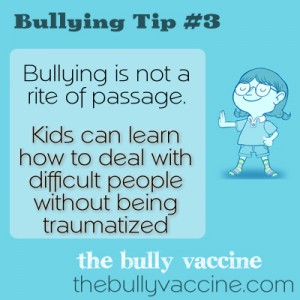5 things we need to do to stop bullying in the schools.
When it comes to bullying, it doesn’t seem like much of anything can be done to stop it. To a certain extent, aggression is a normal part of human behavior. But just because some people are aggressive, doesn’t mean we have to accept bullying as inevitable.
One of the problems we have when addressing bullying in schools is that most anti-bullying programs focus on prevention only. Prevention is hugely important. But it’s an incomplete strategy. After all, prevention only helps kids who haven’t yet been bullied. We also need to help kids who are currently being bullied learn how to get it to stop. What we need is a more comprehensive approach.
Here are 5 things we need to do to stop bullying in the schools.
1) We have to teach kids who are being bullied right now how to get it to stop. The only method that is successful in eliminating unwanted behavior is the extinguishing a behavior protocol from operant conditioning. We use it to sleep train babies and to quit smoking and for weight loss. We need to start applying it to bullying as well. The good news is that these skills are fairly easy to teach and they work really well, which is why all reputable anti-bullying programs already teach the first part of this protocol, how to not reward a bully. What’s missing is the rest of the protocol. Specifically, what happens after you stop rewarding a bully’s bad behavior? Without that knowledge kids will fail. Kids need to be taught to expect the escalation and retaliation that is predicted behavior so that they not only understand what is happening but so that they can manage it properly and complete the extinction process. If they stop, because they think it isn’t working when it actually is because no one bothered to explain HOW this process worked, they will make their situation worse. That’s unacceptable. We have to do better. We need to teach the complete protocol and not just the first part of it.
2) We need to make sure there is proper bystander training. Bystander training helps with both prevention and elimination. Again, the good news is that when you teach a kid how to get a bully to stop using operant conditioning, you empower them to be upstanders who speak out against bullying in the future. When a child has the skills necessary to face down a bully, they aren’t afraid to intervene on behalf of others. .
3) We need to focus on our youngest grades. We need to teach bullying elimination techniques so that when this behavior first emerges, it is stopped so young kids who would otherwise learn to bully, don’t. Bullies don’t suddenly emerge fully formed in the middle grades. They learn this behavior when they are younger. When bullying behavior is left unchecked in the younger grades, it not only flourishes, it escalates and becomes worse during the middle grades. This is not a problem of hormones run amok. This is a problem of us adults not intervening and stopping these behavior patterns from becoming established when our kids are younger.
4) We need to provide mental health assistance and care for individuals who are bullying maladaptively and/or as a result of mental illness, and …
5) We have to create new administrative processes that increase the speed of response time with a focus on elimination rather than conflict mediation. Conflict mediation protocols strengthen bullying behavior. We have to set up reporting and investigation processes with the full extinction protocol in mind, otherwise we will make things worse and exacerbate the bullying problem. For this to happen, schools and administrators responsible for setting up policies need to have a better understanding of EXACTLY what is required to extinguish bullying behavior. Without that, their policies, while well intentioned, will be counterproductive.
To read a comprehensive version of this 5 point strategy to go: https://docs.google.com/file/d/0B0L27xd7NclMVG9vb0dNbXpuUmc/edit?usp=sharing

